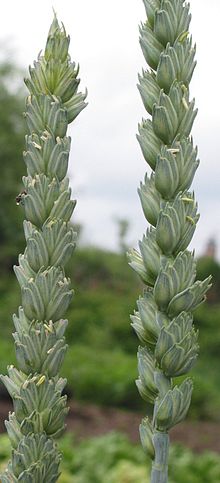Common wheat: Difference between revisions
| Line 40: | Line 40: | ||
==List of the cultivars == |
==List of the cultivars == |
||
* Albimonte |
* Albimonte <ref name=ijtc>{{cite journal |
||
| last = di Toppi |
|||
| first = Luigi Sanità ''et al.'' |
|||
| authorlink = |
|||
| coauthors = |
|||
| title = Occurrence of different inter-varietal and inter-organ defence strategies towards supra-optimal zinc concentrations in two cultivars of ''Triticum aestivum'' L. |
|||
| journal = Environmental and Experimental Botany |
|||
| volume = 66 |
|||
| issue = 2 |
|||
| pages = 220 - 229 |
|||
| publisher = |
|||
| location = |
|||
| date = 2009 |
|||
| url = |
|||
| issn = |
|||
| doi = 10.1016/j.envexpbot.2009.02.008 |
|||
| id = |
|||
| accessdate = 5 June |
|||
| accessyear = 2009}}</ref> |
|||
* Manital |
* Manital |
||
Revision as of 23:52, 4 June 2009
This article includes a list of references, related reading, or external links, but its sources remain unclear because it lacks inline citations. (July 2007) |
| Common wheat or bread wheat | |
|---|---|

| |
| Ears of common wheat | |
| Scientific classification | |
| Kingdom: | |
| (unranked): | |
| (unranked): | |
| (unranked): | |
| Order: | |
| Family: | |
| Subfamily: | |
| Tribe: | |
| Genus: | |
| Species: | T. aestivum
|
| Binomial name | |
| Triticum aestivum | |
Common wheat, Triticum aestivum, (also known as bread wheat) is a cultivated wheat species.
Evolution
Bread wheat is an allohexaploid (an allopolyploid with six sets of chromosomes, two sets from each of three different species). Free-threshing wheat is closely related to spelt. As with spelt, genes contributed from goatgrass (Aegilops tauschii) give bread wheat greater cold hardiness than most wheats, and it is cultivated throughout the world's temperate regions.
Recent history
The examples and perspective in this article may not represent a worldwide view of the subject. |
Wheat first reached North America with Spanish missions in the 16th century, but North America's role as a major exporter of grain dates from the colonization of the prairies in the 1870s. As grain exports from Russia ceased in the First World War, grain production in Kansas doubled. Worldwide, bread wheat has proved well adapted to modern industrial baking, and has displaced many of the other wheat, barley, and rye species that were once commonly used for bread making, particularly in Europe.
Plant breeding
Modern wheat varieties have short stems, the result of RHt dwarfing genes that reduce the plant's sensitivity to gibberellic acid, a plant hormone that lengthens cells. RHt genes were introduced to modern wheat varieties in the 1960s by Norman Borlaug from Norin 10 cultivars of wheat grown in Japan. Short stems are important because the application of high levels of chemical fertilizers would otherwise cause the stems to grow too high, resulting in lodging (collapse of the stems). Stem heights are also even, which is important for modern harvesting techniques.
Other forms of common wheat

Compact wheats (e.g. club wheat Triticum compactum, but in India T. sphaerococcum) are closely related to common wheat, but have a much more compact ear. Their shorter rachis segments lead to spikelets packed closer together. Compact wheats are often regarded as subspecies rather than species in their own right (thus T. aestivum subsp. compactum).
Nomenclature and taxonomy
This section needs expansion. You can help by adding to it. |
List of the cultivars
- Albimonte [1]
- Manital
This section needs expansion. You can help by adding to it. |
References
- Bonjean, Alain P. and William J. Angus (eds) (2001). The world wheat book : a history of wheat breeding. Andover: Intercept. p. 1131. ISBN 1898298726.
{{cite book}}:|author=has generic name (help) Excellent resource for 20th century plant breeding. - Caligari, P.D.S. and P.E. Brandham (eds) (2001). Wheat taxonomy : the legacy of John Percival. London: Linnean Society, Linnean Special Issue 3. p. 190.
{{cite book}}:|author=has generic name (help) - Heyne, E.G. (ed.) (1987). Wheat and wheat improvement. Madison, Wis.: American Society of Agronomy. p. 765. ISBN 0891180915.
{{cite book}}:|author=has generic name (help) - Zohary, Daniel and Maria Hopf (2000). Domestication of Old World plants: the origin and spread of cultivated plants in West Asia. Oxford: Oxford University Press. p. 316. ISBN 0198503563. Standard reference for evolution and early history.
See also
- ^ di Toppi, Luigi Sanità; et al. (2009). "Occurrence of different inter-varietal and inter-organ defence strategies towards supra-optimal zinc concentrations in two cultivars of Triticum aestivum L.". Environmental and Experimental Botany. 66 (2): 220–229. doi:10.1016/j.envexpbot.2009.02.008.
{{cite journal}}:|access-date=requires|url=(help); Check date values in:|accessdate=(help); Cite has empty unknown parameter:|coauthors=(help); Explicit use of et al. in:|first=(help); Unknown parameter|accessyear=ignored (|access-date=suggested) (help)

